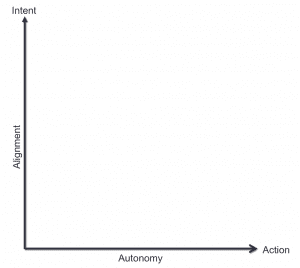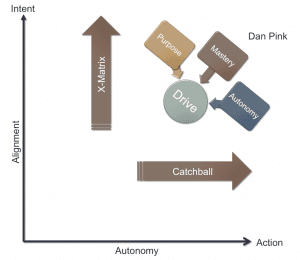Following on from my previous What is Strategy Deployment and Dynamics of Strategy Deployment posts, there is a model I like which I think helps to show how the mechanics and the dynamics work together.
In The Art of Action, Stephen Bungay describes how Field Marshall Helmuth von Moltke, Chief of Staff of the Prussian Army for 30 years from 1857, had an important insight regarding Alignment and Autonomy. Previously these two had been viewed as extremes at the end of a single scale. Having high alignment meant having no autonomy because alignment could only be achieved through defining detailed plans which everyone should follow. Equally, high autonomy meant having no alignment because autonomy would result in everyone doing their own thing with no regard for each others actions.
Von Moltke’s insight was that alignment and autonomy are not a single scale requiring a tradeoff between the two ends, but two different axis which can actually reinforce each other. Thus not only is it possible to have both high alignment and high autonomy, but high alignment can enable high autonomy.
They key to making this possible is differentiating between intent and action. Alignment is achieved by clearly stating intent centrally, such that autonomy can be achieved by allowing action to be decentralised in support of the intent. This requires mechanisms to both clarify and amplify intent, and enable and encourage local action. Thus using the definition of Strategy Deployment as “any form of organisational improvement in which solutions emerge from the people closest to the problem”, solving the problem is the intent, and the emerged solution is the action.
Using this model we can now describe two mechanisms necessary to make this happen. Alignment can be achieved with the X-Matrix, which enables the conversations about intent and summarises and visualises the results of those conversations. In other words, the X-Matrix shows how results, strategy, outcomes and tactics align and reinforce each other. Autonomy can be achieved through Catchball (Bungay describes the equivalent as back-briefing), which enables the X-Matrix to be passed around the organisation such that everyone can reflect, give feedback, and improve it, helping focus action on meeting the intent.
Viewing Strategy Deployment in this light also highlights a symmetry with the Autonomy, Mastery and Purpose model of intrinsic motivation described by Dan Pink in his popular book Drive. Autonomy is a direct match in both models and purpose is equivalent to intent. Mastery is then the result of improving capability autonomously with strong alignment to intent.
What this way of looking at Strategy Deployment shows is that both the X-Matrix and Catchball are necessary components. Just using the X-Matrix with out Catchball will probably result in it being used as just another top-down document to command and control employees. Similarly, just using Catchball without an X-Matrix will probably result in collaboration around local improvements with no overall organisational improvement.



